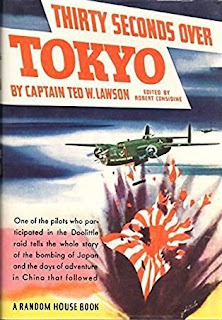Thirty Seconds Over Tokyo
 Thirty Seconds Over Tokyo, by Capt. Ted W. Lawson
Thirty Seconds Over Tokyo, by Capt. Ted W. LawsonA while back, a very elderly copy of this famous book came across the donation table, and my mom mentioned that the author, Ted Lawson, lived here in our town in his later years, and is buried here. So I figured I'd better read it! I honestly did not know anything about this book or the events he describes -- meanwhile, my husband said "Oh yeah, that's about the Doolittle raid, right?" Maybe! Let's find out! (What's the Doolittle raid?)
Lawson wanted to go into aeronautical research, and in 1940 he figured one step would be to join the Air Force to gain more hands-on experience. So he became a pilot and flew a B-25 bomber. He and the rest of his class volunteered for a "dangerous, important, and interesting" mission that they weren't allowed to know anything about until they were already underway. After strenuous training, they got on to the aircraft carrier USS Hornet and were told that they would be bombing strategic targets in Japan as an answer to the Pearl Harbor bombing; the Japanese leaders were completely confident that Japan could not be bombed, because nobody could reach them, and the plan was to prove otherwise. Since the mission was led by Lieutenant Colonel James Doolittle, it's known as the Doolittle Raid.
 |
| A B-25 plane |
Local fishermen found and cared for the airmen, but Japanese troops were close by and searching for them. The airmen had to be carried to help, and the trip took several days. Lawson was close to death by the time they reached a missionary outpost and a local doctor, and eventually his leg had to be taken off. As the Japanese troops moved ever closer, another long trek began -- they had to find an airfield that had not yet been destroyed or taken over. It took months to get from the crash site to a safe haven and out of China, and then Lawson needed a lot more surgery and medical care.
Fully half the memoir is the story of moving through China with the help of innumerable locals, many of whom paid a heavy price to the Japanese invaders. The 'thirty seconds over Tokyo' to drop just four bombs took months of training and more months of recovery, and not everyone made it back.
I really enjoyed Lawson's voice; he is just really likeable and fun to read, and reminded me of old stories I used to read at my grandmother's house -- she had books of old Bill Mauldin cartoons and whatnot. At the beginning, Lawson has a lot of good stories, and by the end, he just keeps trying to express his gratitude to his fellow soldiers and for the people who so selflessly cared for him.
Here's a bit about his buddy's plane; the left brake failed upon landing and Bob nearly hit Lawson's own plane:
...those B-25's like to roll on forever. He was rolling much too fast to turn to the left, for that would have rolled off his tired and tipped him over. Finally his right tire blew out from the uneven pressure put on it. The B-25 swung around, just short of my hemmed-in plane, and simply fell to pieces. You should have seen those fellows pouring out of it!
My copy of this memoir was printed in 1944, and it's quite possible that newer editions have been slightly edited for language, since Lawson, of course, uses a few terms that we wouldn't now. I'd be curious to know. My copy doesn't have a dustcover any more, but as far as I can tell, the cover image I've put at the top is the one that it used to have.
As I said above, Lawson is buried here in our town. Maybe I'll go visit!






I had always thought the Doolittle Raid was a little silly. A lot of sacrifice to drop 4 bombs.
ReplyDeleteBut I read a book written by a Japanese navel pilot who was at Pearl Harbor and Midway (I think, "Midway: The Battle That Doomed Japan." I gave it to Dad.)
Anyway, in that book he describes the Doolittle Raid as a huge psychological blow to the Japanese leadership. They were absolutely confident the sacred home islands could never be attacked, and they directly felt the failure of their defense. According to him the Doolittle Raid drove the strategic blunders that ended up crippling Japan.
Yeah, it seems like a lot to go through for a single raid, but I too read that it was a huge blow to the Japanese military leaders. They thought they were invulnerable, I guess. What book was that? I'd be quite interested in reading about the strategies that backfired.
ReplyDeleteIt was, "Midway: The Battle That Doomed Japan, the Japanese Navy's Story." Here's the Amazon link: https://www.amazon.com/Midway-Battle-Doomed-Japanese-Bluejacket/dp/1557504288
ReplyDeleteBut I gave it to Dad for Christmas, so presumably it's floating around that house somewhere. It's mostly about Midway, and how Japan came to attack it.
OK, thanks.
ReplyDeleteThe Japanese killed 250,000 Chinese in reprisal.
ReplyDeletehttps://www.warhistoryonline.com/instant-articles/american-doolittle-raid.html
Worse than the treatment of Nanking. Kinda deflates one's admiration of Bushido.